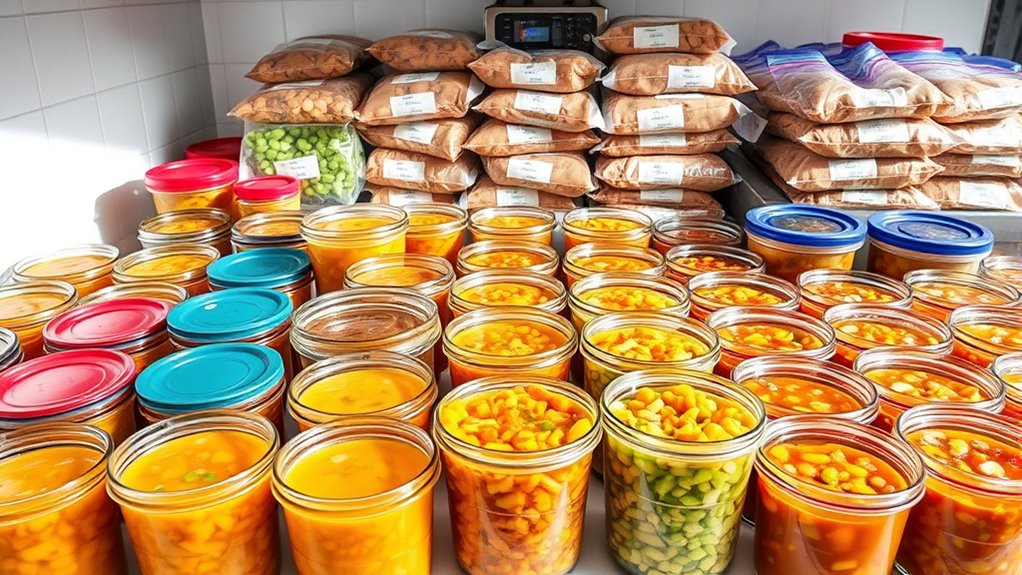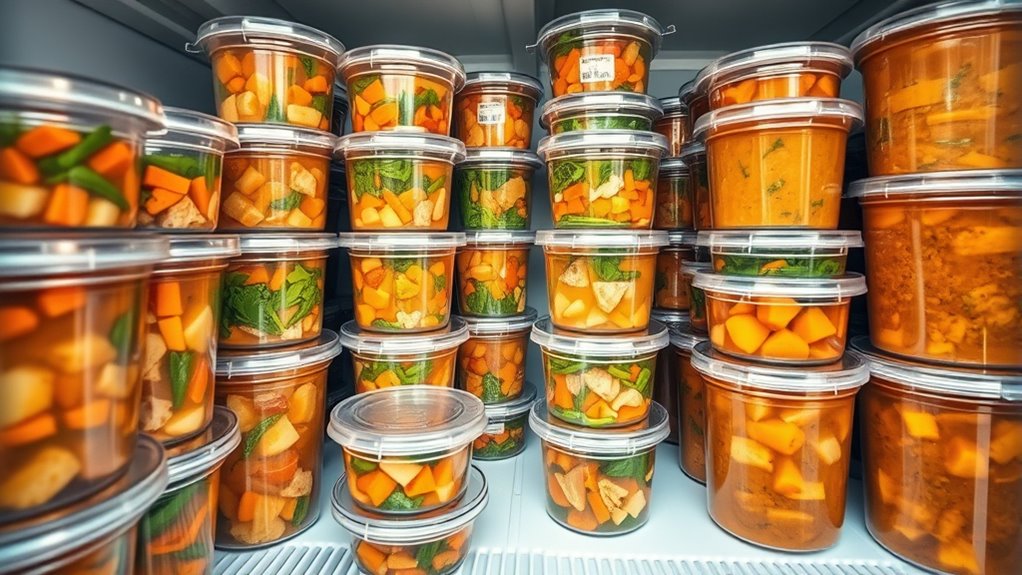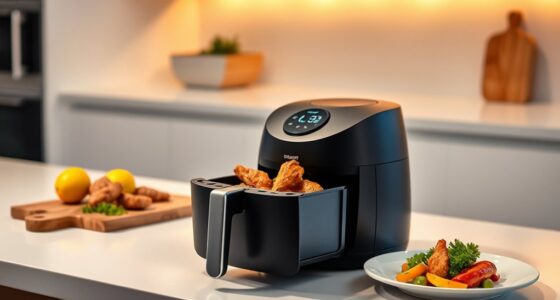Batch cooking soups and stews and storing them in airtight, freezer-safe containers makes busy weeks much easier. Use portioned servings, label containers with dates, and leave space for expansion. Cool dishes thoroughly before freezing and reheat them safely in the microwave or oven. Proper organization and freezing techniques help prevent freezer burn and keep meals fresh. For tips on storage, reheating, and maximizing space, you’ll find useful ideas ahead.
Key Takeaways
- Use airtight, freezer-safe containers like glass or BPA-free plastic, leaving headspace for expansion.
- Portion soups and stews into single servings, label with dates, and organize for easy access.
- Cool dishes to room temperature before freezing, and utilize ice baths or dividing to speed cooling.
- Thaw leftovers in the fridge overnight or reheat directly from frozen in microwave-safe containers.
- Batch cook to save time, reduce daily effort, and ensure nutritious meals are ready throughout busy weeks.

Batch cooking soups and stews is a smart way to save time and guarantee you have delicious, homemade meals ready to go. When you prepare large quantities at once, you can streamline your week and reduce daily cooking stress. To do this effectively, you need solid meal prep strategies that help you organize and store your dishes efficiently. Start by choosing the right storage container options. Opt for durable, freezer-safe containers made from glass or BPA-free plastic. Glass containers are excellent because they don’t stain or retain odors and are safe to reheat directly in the microwave or oven. Snap-on lids with airtight seals help prevent freezer burn and keep your soups and stews fresh longer.
Batch cook soups and stews using durable, freezer-safe glass or BPA-free containers with airtight lids.
Before you begin cooking, consider portioning out your soups and stews into individual servings. This way, you can easily grab a container, heat just what you need, and avoid thawing entire batches when you only want a single meal. Using clear containers or labeling your storage options with dates and contents can help you stay organized and prevent confusion. Labeling is a key part of your meal prep strategies because it guarantees you consume the oldest leftovers first, reducing waste and maintaining freshness.
When filling your containers, leave some headspace at the top to accommodate liquid expansion during freezing. Once sealed, place your containers in the freezer, making sure they’re stored upright on a flat surface. To maximize space, consider stacking containers with similar sizes or using adjustable shelves if your freezer allows. Keep in mind that some soups and stews freeze better when cooled to room temperature first, but avoid leaving them out too long to prevent bacterial growth. Proper freezer storage techniques can help preserve quality and prevent freezer burn, ensuring your meals stay fresh longer. Use an ice bath or divide the cooling process to speed it up safely.
Thawing your pre-made soups and stews is straightforward. Transfer a container from the freezer to the fridge the night before you plan to eat. For quicker options, some containers are microwave-safe, allowing you to reheat directly. This method saves you time and ensures your meals are ready when you need them most. By incorporating strategic planning in your meal prep and choosing the right storage container options, you can enjoy homemade soups and stews all week long, without the hassle of daily cooking. This approach guarantees variety, saves money, and gives you more time to focus on other important things in your busy schedule.
Frequently Asked Questions
How Long Can Cooked Soups and Stews Be Stored in the Freezer?
You can typically store cooked soups and stews in the freezer for up to 3 to 4 months for maximum quality. Be mindful that soups with dairy may only stay good for about 1 to 2 months, as dairy can spoil faster. Proper freezer storage durations help prevent freezer burn and maintain flavor, so label containers clearly and consume within recommended timeframes to enjoy safe, tasty leftovers.
Can I Freeze Soups With Dairy or Pasta Ingredients?
You can freeze soups with dairy or pasta, but dairy preservation may cause slight changes in texture, so expect some separation or thickening upon thawing. Pasta tends to absorb liquid and become mushy, affecting pasta texture. To minimize these issues, consider adding dairy after reheating and cooking pasta fresh when you’re ready to serve. This way, you maintain the best flavor and texture in your frozen soups.
What Is the Best Way to Reheat Frozen Soups and Stews?
Imagine opening your freezer and pulling out a perfectly stored soup or stew. To reheat, you can microwave it in short bursts, stirring frequently to prevent hot spots, or reheat on the stovetop over medium heat. Cover it to retain moisture, and stir often to make certain even warming. Both methods help preserve flavor and texture, making your meal just as delicious as when it was first cooked.
How Do I Prevent Freezer Burn on My Soups and Stews?
To prevent freezer burn on your soups and stews, you should store them in airtight containers or tightly wrap them with freezer wrap. Make sure to remove as much air as possible before sealing to minimize exposure to moisture and air, which cause freezer burn. Label your containers with dates, so you use the oldest first. Properly sealed, your soups and stews stay fresh and delicious longer.
Are There Any Soups or Stews That Don’t Freeze Well?
Some soups and stews don’t freeze well, especially those with fragile ingredients like potatoes or pasta, which can become mushy or lose their texture after freezing. Also, dairy-based soups may experience texture changes, making them less appealing after thawing. If you want to freeze these, consider adding delicate ingredients fresh when reheating. This way, you preserve the intended texture and flavor, ensuring a tasty meal every time.
Conclusion
By batch cooking soups and stews and freezing them, you’ll turn your freezer into a treasure trove of instant comfort, saving you hours of stress and endless dinner dilemmas. Imagine walking into your kitchen on the busiest day ever, and instead of panic, you’re greeted by a fortress of ready-to-eat, steaming bowls of deliciousness. It’s like having a magic pantry that transforms chaos into calm—your secret weapon for effortless, joyful mealtimes every single week!









